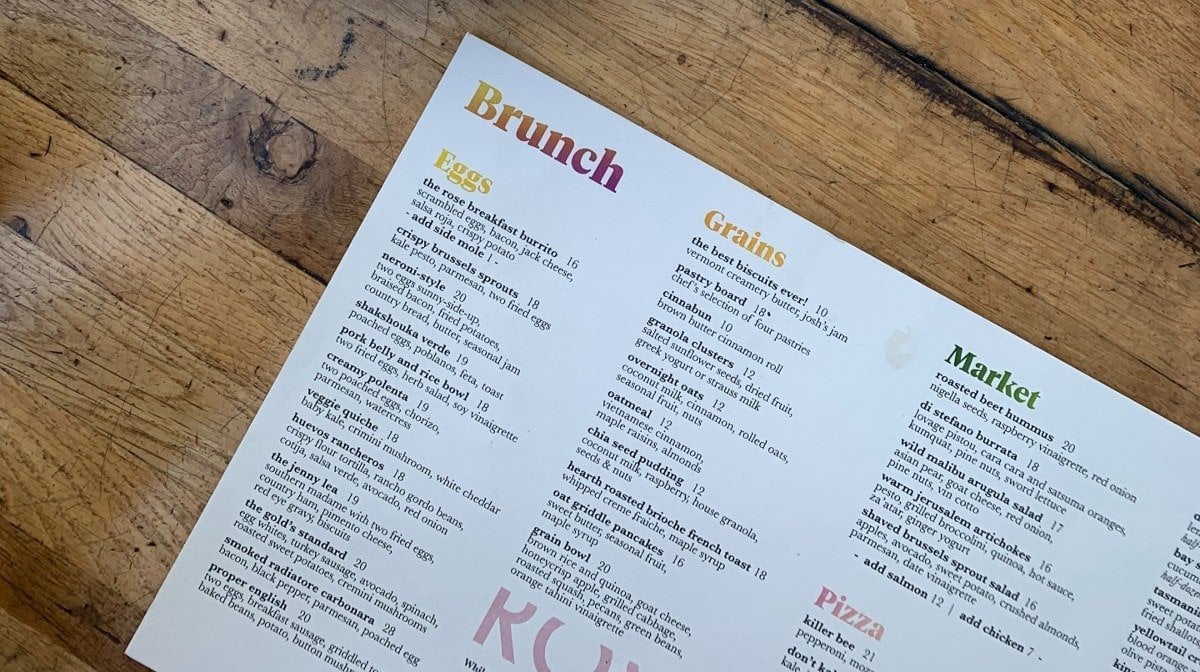
Restaurants, cafes and takeaways in England with 250 or more employees are now required to display calories on their menus. This latest measure is part of the government’s drive to tackle obesity, but it has been met with scepticism from business owners, public health experts, and some campaigners, who believe it will cause harm to people with eating disorders.
While there are some possible benefits to the change, there are also likely to be many negatives, both short and long term. In this article I’ll go through both, assessing whether the policy is likely to succeed or if it will cause more harm than good.
"Children and adults are consuming too many calories”
The government’s own impact assessment document, which sets out the policy’s aims and likely effects, makes this claim:
On the surface, the policy’s intentions seem fair enough. But a little bit of probing reveals the possible hazards of the intervention and explains why some affected parties have cause for concern. As ever, the best way to evaluate it is by focusing on data and research.
Is mandatory calorie labelling on menus justified?
It’s true that obesity is a growing problem in the UK, and while some people may claim the issue is exaggerated, steps must be taken to reduce its impact.
Speaking as someone who was once morbidly obese, I believe it’s worth saying that body positivity must not deny that obesity carries greater risk of serious health conditions. Saying so is not “fatphobic”, rather simply a statement of fact.
Obesity is often the result of behaviours that have led to excessive body fat accrual (1). This is predominantly caused by too much food and too little activity. Body fat gain doesn’t work the same for everyone though; genetic, socioeconomic and other environmental factors all contribute too (2).
Obesity is a problem getting bigger in the UK, and it’s increasing at an alarming rate. Recently published reports (3) show that obesity levels have almost doubled since 1993 (15% to 28%) and three-quarters of those aged between 45 and 74 are overweight or obese.
The rates of obesity in children are even more worrying: one in seven children are obese by age 5 and one in four are obese by age 11. Deprived children are also more likely to be obese, and this gap is continuing to widen.
“Eating out accounts for a significant proportion of people’s energy intake”
This part of the statement is difficult to address because it’s not explained what a “significant” proportion of energy intake is. A 2017 study may shine some light on the situation though; the researchers used data archived from the UK National Diet and Nutrition Survey.
The study found that UK adults who ate out at least once weekly had a higher average daily energy intake (consuming 75-104 more calories per day) than those who rarely went out for dinner. The equivalent figures for takeaway meals eaten at home were 63-87 more calories.
Children who ate takeaway meals at home at least weekly consumed 55-168 calories more per day than those who ate these meals rarely. Additionally, they found that the children who came from less affluent backgrounds tended to consume a higher number of calories per meal.
According to the government’s assessment statement, adults should aim for 2000 calories a day (this is confusing because the government’s official dietary guidelines suggest 2500 calories for men and 2000 calories for women) (5).
Going by these figures, it’s reasonable to presume that the government is defining about 10% as the “significant” proportion of daily energy intake. Without further explanation and detail of impact on weight and health outcomes, it’s hard to know if this 10% increase in energy intake is indeed significant or not.
“When eating out, however, there is limited access to energy information making it difficult for consumers to identify healthier options for themselves and their families”
This is contentious because most restaurants and dining sector businesses do provide nutritional information online or upon request.
Additionally, low-quality diets associated with less affluent households have been consistently found to be an issue of poverty not education.
Affordability, accessibility, cooking skills, access to cooking equipment, free time to cook and exercise are all barriers to achieving a healthy, nutritious diet (6).
“Ensuring this information is available will allow consumers to make informed choices, supporting Government policies to reduce childhood obesity.”
Labelling calories on menus may allow consumers to make informed choices, but will it be effective?
The primary study that the government has used to justify this intervention does indeed back calorie labelling as an effective means of reducing the number of calories consumed in one meal (7).
The paper found that including this kind of calorie labelling reduced the average energy intake when eating out or having takeaway by 81 calories per meal. Whether or not this is a significant enough amount to justify the move is another matter.
One issue with the study is that it involved people from the US and Canada, which are not representative of the UK.
The closest study I found — recent, representative of the UK, and involving the kind of intervention the government is introducing — showed no benefit in reducing calorie consumption per meal (8).
In fact, at the one site that showed some positive benefit (with the peak of this benefit being noted on the first day of the intervention), the researchers found that food selection and calorie intake eventually returned to normal.
When we look at how these interventions shape children’s choices, it’s even more gloomy. One large scale study (9) reviewed all the available literature surrounding calorie labelling measures and found that there was no effect on reducing children’s calorie intake (neither when they were choosing themselves nor when an adult was choosing for them).
Potential for harm and sector recovery issues
Aside from questions over whether the intervention will be effective for reducing people’s calorie intakes, some campaigners believe it will cause harm in other ways.
Tom Quinn, director of external affairs for Beat, a UK eating disorder charity, said there was evidence that calorie information causes anxiety and distress for people affected by eating disorders.
As well as those with a history of eating disorders, there are others who may also suffer from this new legislation.
When you go for a meal out with friends, family or a loved one, is the first thing that comes to your mind “calories” or is it the actual experience you’re about to have?
Critics from within the restaurant sector suggest the quality of the dining experience may be hampered by businesses feeling obliged to meet certain calorie quotas, with chefs sacrificing flavour and creativity for lower calorie figures.
Another thing to consider is the practicality of providing accurate nutritional information. Demanding consistently accurate nutritional information means that chefs and cooks must ensure that every portion is the exact same. If you’ve ever cooked in your life, you’ll know how difficult that is to do for yourself or a group of people. Now, imagine how difficult that would be if you were doing hundreds of covers a day...
I don't know about you, but I certainly feel for the culinary staff; I just don't think that those pushing this mandate forward have thought logically about the practicality of what they’re asking for.
It may also cause worries about the sector’s future. Not only are the financial implications unknown (something the impact assessment itself states) but so is the impact on future generations of chefs and cooks and other kitchen staff.
Could it dissuade those interested in pursuing these careers to explore other options?
Will there be any jobs left to pursue if the sector takes another significant financial hit?
It’s incredibly surprising that this legislation was rolled out without even a pilot study.
Take home message
While calorie labelling on menus aims to tackle the growing problem of obesity in the UK, ultimately it is a misguided, probably ineffective and potentially harmful health intervention.
The intervention ignores many of the factors that lead to obesity and will likely not improve the situation for affected members of the population while harming others. Meanwhile, real issues will remain unaddressed and continue to develop further.
For me, calorie labelling is like pointing a small water pistol at a rampant housefire. I am not a fan.
READ THESE NEXT:

1. Zhang, Y., Liu, J., Yao, J., Ji, G., Qian, L., Wang, J., Zhang, G., Tian, J., Nie, Y., Zhang, Y. E., Gold, M. S., & Liu, Y. (2014). Obesity: pathophysiology and intervention. Nutrients, 6(11), 5153–5183. https://doi.org/10.3390/nu6115153
2. Hruby, A., Manson, J. E., Qi, L., Malik, V. S., Rimm, E. B., Sun, Q., Willett, W. C., & Hu, F. B. (2016). Determinants and Consequences of Obesity. American journal of public health, 106(9), 1656–1662. https://doi.org/10.2105/AJPH.2016.303326
3. Baker, C. (2022) Obesity Statistics, House of Commons Library, https://commonslibrary.parliament.uk/research-briefings/sn03336/#:~:text=The%20Health%20Survey%20for%20England,is%20classified%20as%20’overweight’.
4. Goffe, L., Rushton, S., White, M., Adamson, A., & Adams, J. (2017). Relationship between mean daily energy intake and frequency of consumption of out-of-home meals in the UK National Diet and Nutrition Survey. The international journal of behavioural nutrition and physical activity, 14(1), 131. https://doi.org/10.1186/s12966-017-0589-5
5. Public Health England (2016). Government dietary recommendations. https://assets.publishing.service.gov.uk/government/uploads/system/uploads/attachment_data/file/618167/government_dietary_recommendations.pdf
6. Vilar-Compte, M., Burrola-Méndez, S., Lozano-Marrufo, A. et al. (2021). Urban poverty and nutrition challenges associated with accessibility to a healthy diet: a global systematic literature review. Int J Equity Health 20, 40. https://doi.org/10.1186/s12939-020-01330-0
7. Sinclair, S. E., Cooper, M., & Mansfield, E. D. (2014). The influence of menu labelling on calories selected or consumed: a systematic review and meta-analysis. Journal of the Academy of Nutrition and Dietetics, 114(9), 1375–1388.e15. https://doi.org/10.1016/j.jand.2014.05.014
8. Vasiljevic, M., Cartwright, E., Pilling, M. et al. (2018). Impact of calorie labelling in worksite cafeterias: a stepped wedge randomised controlled pilot trial. Int J Behav Nutr Phys Act 15, 41. https://doi.org/10.1186/s12966-018-0671-7
9. Kiszko, K. M., Martinez, O. D., Abrams, C., & Elbel, B. (2014). The influence of calorie labeling on food orders and consumption: a review of the literature. Journal of community health, 39(6), 1248–1269. https://doi.org/10.1007/s10900-014-9876-0






